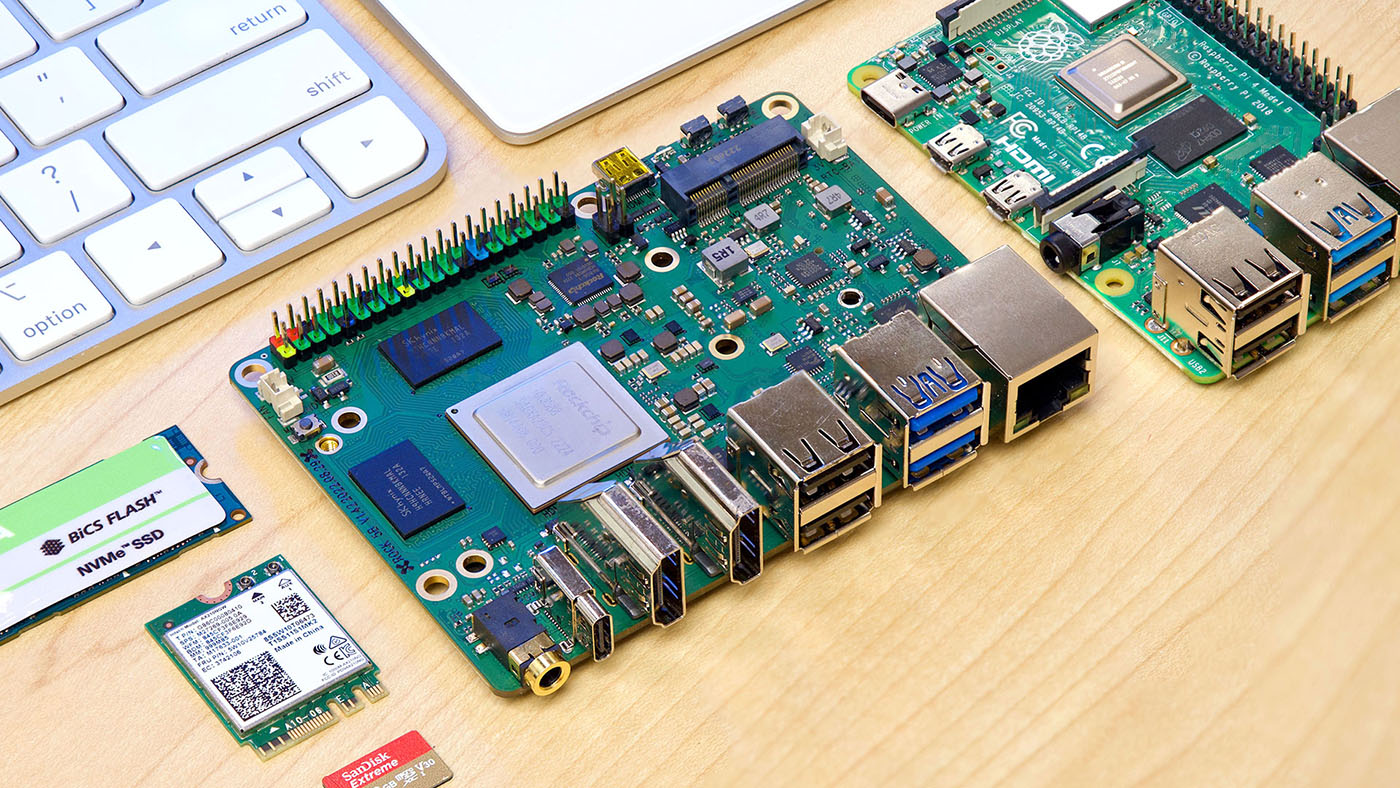
Radxa's Rock 5 model B is an ARM single board computer that's 3x faster than a Raspberry Pi. And that's just the 8-core CPU—with PCI Express Gen 3 x4 (the Pi has Gen 2 x1), storage is 7x faster! I got over 3 GB/sec with a KIOXIA XG6 NVMe SSD.
It's still half as slow as modern ARM desktops like Apple's M1 mini, or Microsoft's Dev Kit 2023 (see my review here). But it's way faster than a Pi, it comes with 2.5 Gig Ethernet, it has two M.2 slots on board... and, well—it also starts at $150!
So you get what you pay for, in terms of performance. But I wanted to know: for a premium SBC price, do you get a better experience?
The thing that turns me off with so many Pi alternatives is how hard it is to go from unboxing the board to actually using it. Being able to just plug it in, install an OS, and... do stuff.
But for Linux, and for running open source software, how does this board stack up? Is it worth paying $150-220 for a more premium SBC?
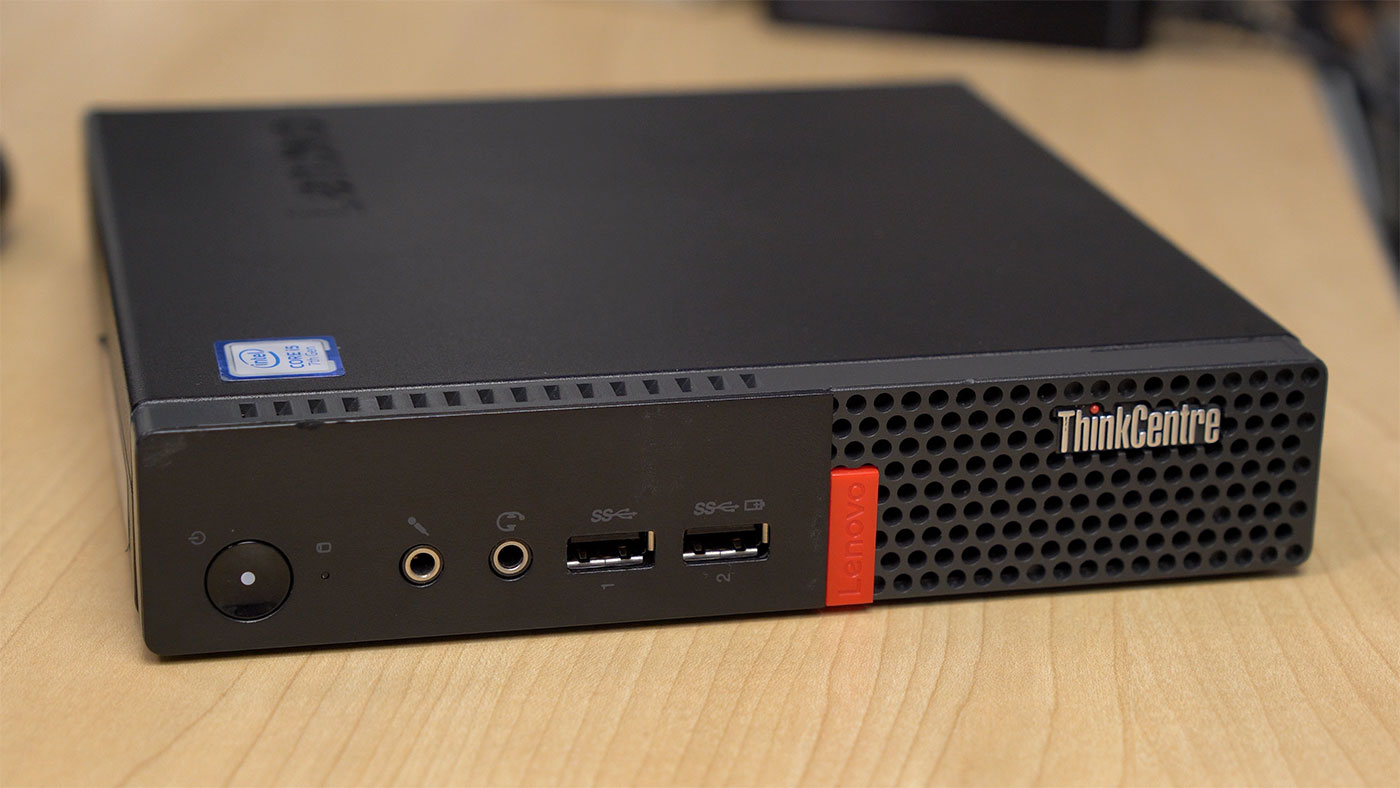
Or for that price should you just go ahead and buy a used TinyMiniMicro PC, like the Lenovo M710q (pictured above) with a full Intel Core i7 processor, an enclosure, a hard drive, WiFi, and a power supply! And this thing has upgradeable RAM, too!
So how does the Rock 5 model B stack up?
If you'd rather watch the video instead of read this blog post—watch my full review of the Rock 5 model B on YouTube:
Specs, price, shipping
This board uses the latest RockChip RK3588 SoC, with an 8 core CPU, a Mali GPU, a 6 TOPS NPU, and 8k encoding and decoding—though, besides the CPU, it's not always easy taking advantage of those other features.
You can get up to 16 GB of RAM, and it can run up to three displays. It says it can do 8K, though it won't perform amazing running anything on an 8K display, just like the Pi performs pretty poorly when you're running a 4K display.
But unlike the Pi, the USB-C port can also do DisplayPort output.
It has an HDMI input, too, but it looks like support for it isn't great yet, if this Explaining Computers video is any indication.
It has built-in 2.5 Gbps Ethernet, two USB 2.0 ports, two USB 3.1 ports, and a mini audio jack.
Up top there's an E-key M.2 for WiFi or other PCI Express devices, and on the bottom, there's another M.2 slot, and this one is a lot more fun. It's M-key for NVMe SSDs, but if you get an M.2 to x16 PCIe adapter, you can break out the slot for more interesting things, like graphics cards—see my notes on that later in this post.
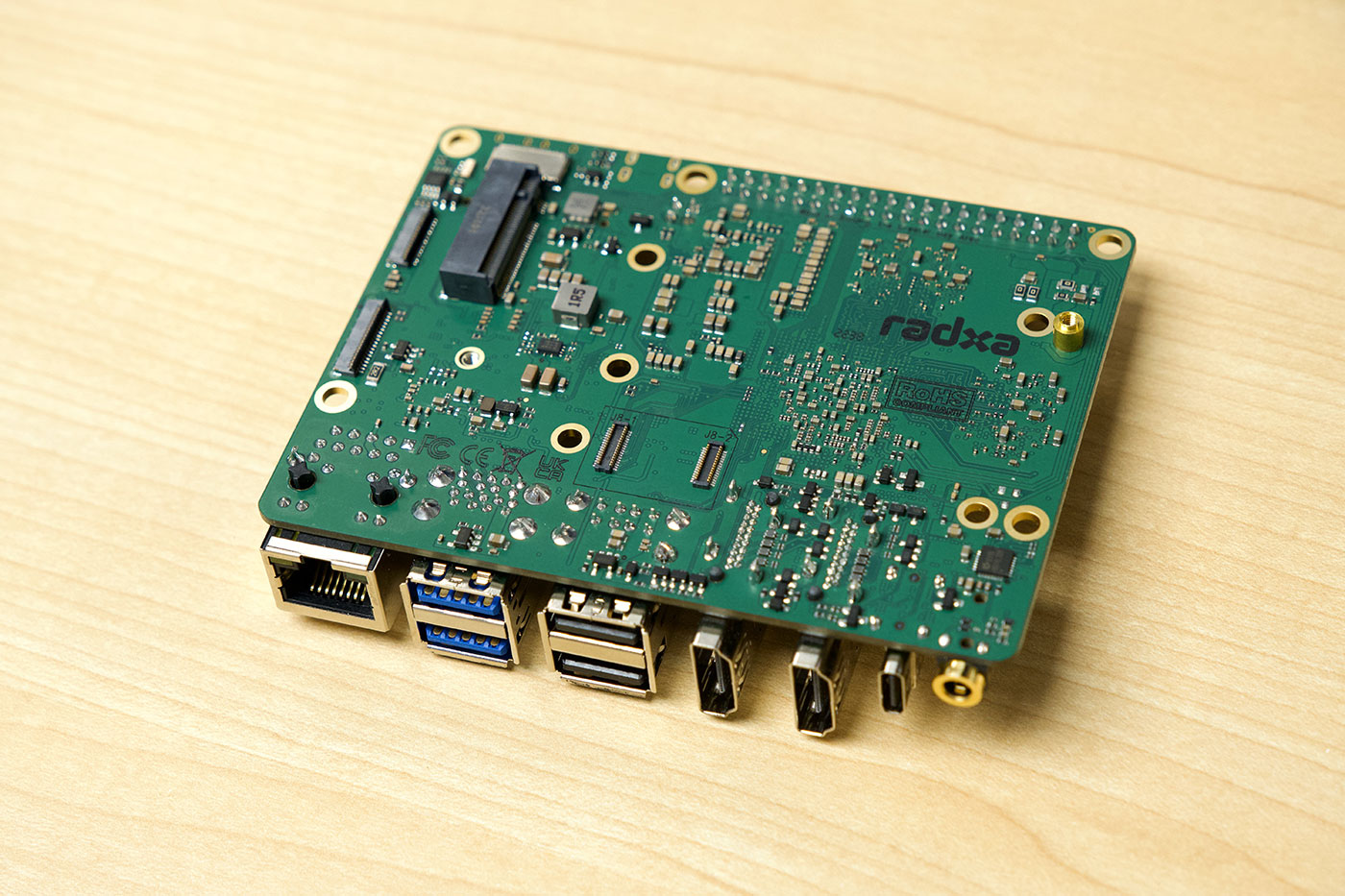
The bottom slot only supports 2280 size SSDs, so if you want to use a shorter SSD you need an M.2 extension adapter. The killer feature is this slot is PCI Express Gen 3 x4. That means you can get up to 4 Gigabytes per second through it!
There's also an eMMC socket and a microSD slot, both of which can be used at the same time, and camera and display connectors.
The one I bought is the 4 GB version, and it costs about $150 shipped.
Initial Setup
To get running, you need a separate power adapter and at least a heatsink. I didn't order the Radxa ones initially, so I stuck on a little heat sink and plugged in a 5v Pi fan.
I wanted to boot the Rock 5 off an NVMe SSD, and apparently you can, but it's a bit tricky and you have to reflash a chip on the board using SPI. So I elected to boot off microSD instead.
The Getting Started Guide on Radxa's Wiki was helpful, but I was a little worried when it kept mentioning a USB to TTL serial cable. This was my first time using this thing, and it seemed pretty daunting having the docs suggest I might want to use a serial console on the first boot!
Luckily a monitor, keyboard and mouse worked just fine—maybe the Getting Started Guide could be a little more focused on just, well... Getting Started. Leave the complicated stuff for later.
I went to the download page and found Android, Debian 11, and Ubuntu images.
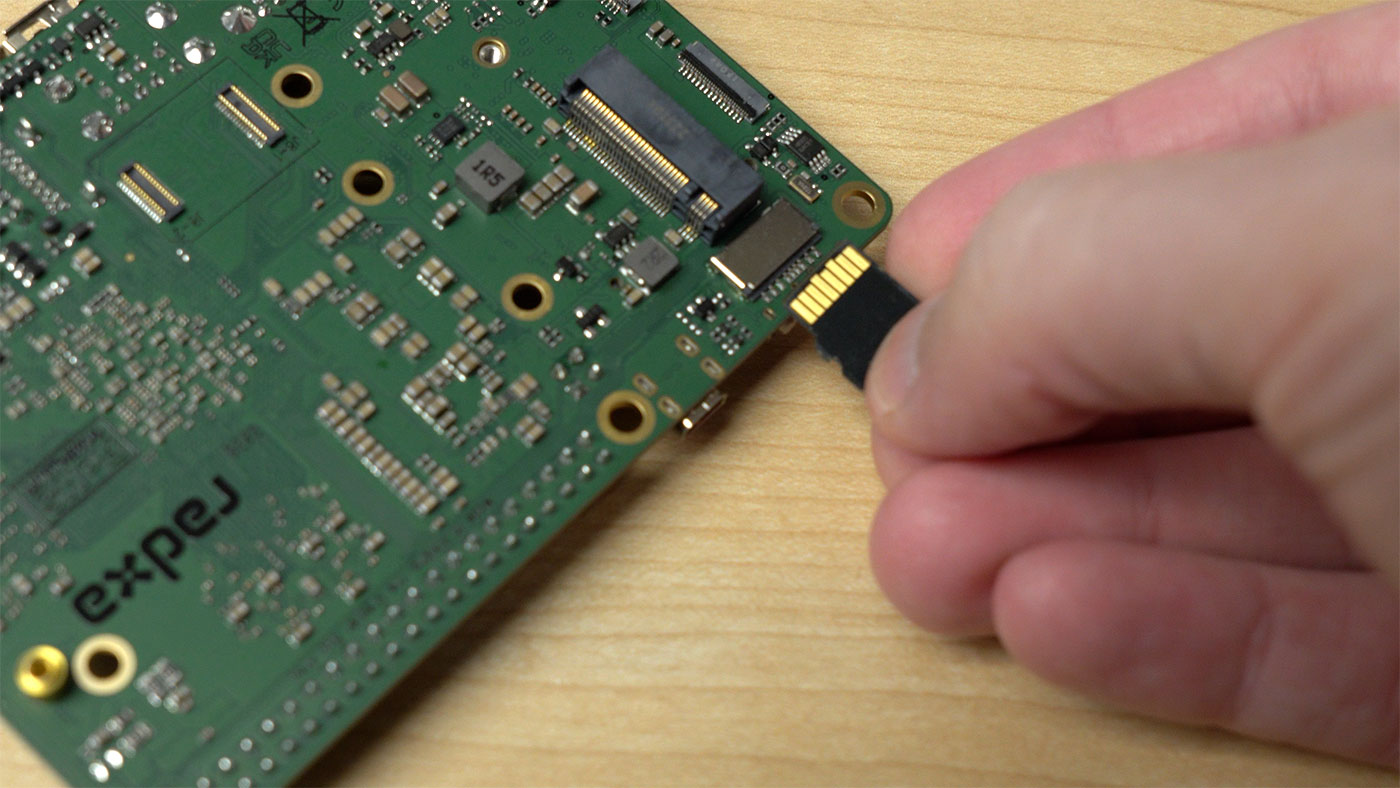
Once the OS was flashed, I plugged the microSD card in, and noticed the tiny microSD card slot allows plugging the card in upside-down (see picture above)! If you do that, good luck figuring out why it won't boot! I'd rather see a full-size microSD card slot like most other boards have.
Power Issues
I didn't initially have Radxa's official 30 watt power supply, so I tried the next best thing, my Apple 30W power supply. I mean, 30W is 30W, right?
Wrong.
Just like the initial version of the Pi 4, USB-C power... can be weird. It's not entirely Radxa's fault, though. USB-C power delivery is anything but easy to implement, so I'm not surprised I had issues.
The LED on the board flashed blue and green, but the board kept resetting itself.
My 61W Apple adapter did actually boot. And I also found this thread on Radxa's forum that gets deeper into power supplies and the Rock 5.
The board's FAQ does have a section on power supplies, and I'd stick with Radxa's recommendation: buy their official power supply. I did, and have had no problems since using it.
First boot
I booted Debian and saw Linux kernel 5.10—it seems this isn't a full Linux 5.10 build. The Linux images are built with a set of Rockchip patches that are based on older Linux releases.
On top of that, the first time I tried running updates, I got an error about Radxa's apt repository not being signed—but I could at least install iperf3 so I ignored that error.
I tested the Ethernet adapter, and I got a consistent 2.35 Gbps down, but less than 1 Gbps up (with --reverse. That's not symmetrical, but it's still plenty fast.
Power usage was around 4-6W on average, and with my little heatsink and Pi fan, the CPU stayed around 30°C.
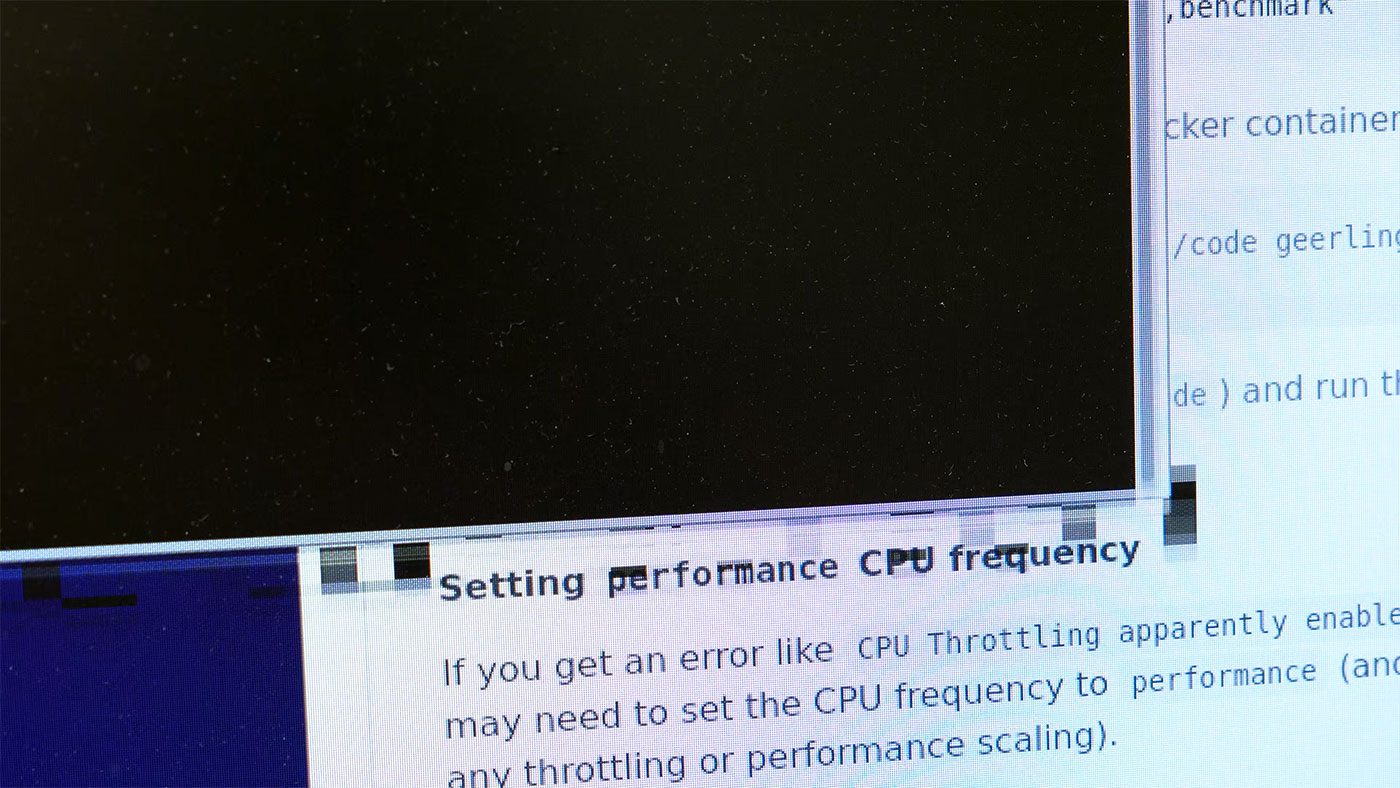
Debian's UI was snappy—certainly faster than a Pi—but I did get strange artifacting on the screen sometimes, like when I opened the Terminal and would see these blotchy parts (see image above).
Performance - CPU
I tried running my Top500 HPL benchmark, but kept running into apt errors. I found this old forum post from November 2020 that had the exact same issue!
The fix was to manually install Radxa's signing key, but it was a bit annoying to have that issue right out of the gate with the latest official Debian image.
With that sorted, I ran Linpack a few different ways—the most efficient is to just use the four A76 performance cores, leaving the four efficiency cores idle. That gave me 46 gflops, using 15W of power. So 3.11 gflops/W.
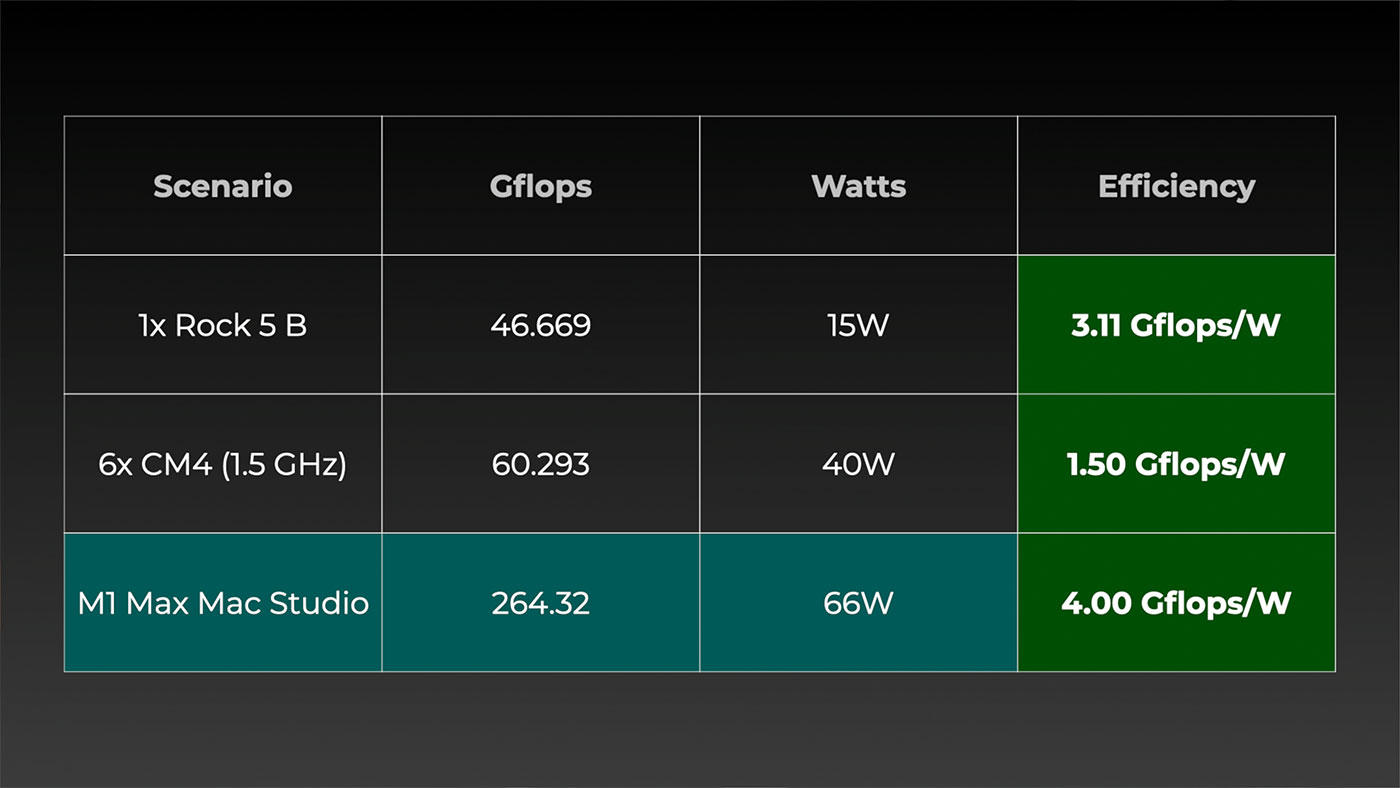
That's a lot better than the Pi 4, and it's almost as efficient on a per-watt bases as my Mac Studio! It's just... a lot slower than the Mac.
Performance was slightly better running on all 8 cores (47 gflops), but efficiency went down a bit (16W, so 2.94 gflops/W). The slower e-cores are better off just running background tasks.
I also tested different cooling configurations:
- Fan and heat sink: 65°C under load
- Fan only: 82°C under load
- Bare SoC (no fan): 85°C and throttling (but still enough to eke out 45 gflops!)
The whole board gets pretty hot, though, so I would recommend at least a heatsink.
I also ran Geekbench to see how this board stacks up, and the Rock 5 scored a respectable 565 single-core and 2384 multi-core.
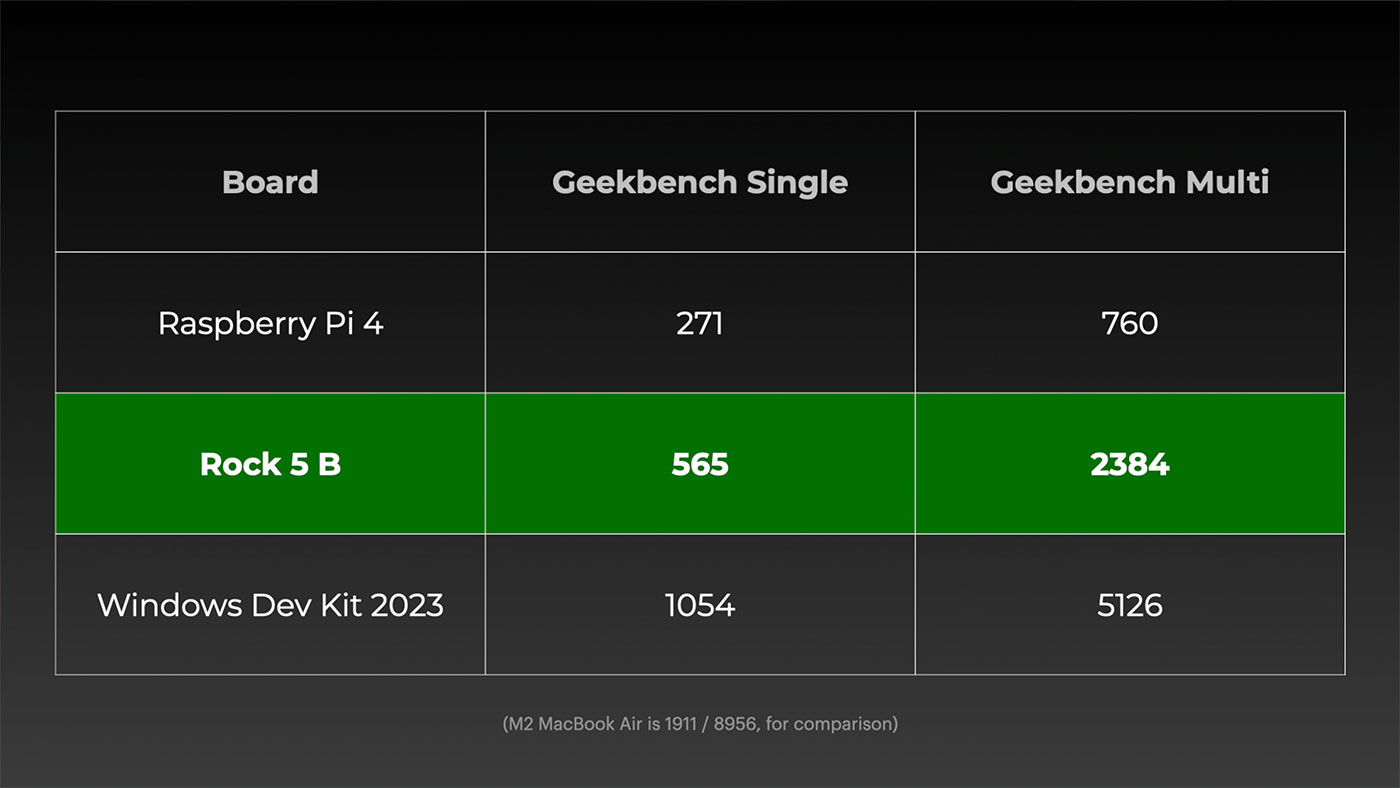
This puts it somewhere between a Raspberry Pi 4 on the lower end, and the Windows Dev Kit 2023 I tested a few months ago.
It's noticeably faster than a Pi, but it's still not a real desktop-class processor. It's not even close to M1 performance, let alone newer M2 CPUs. But... it's a single board computer; it's not really meant to be a desktop.
Performance - Storage
I was most interested in IO performance. There are four lanes of PCI Express Gen 3 in the M.2 slot underneath. The main thing holding the Pi back is IO. I've taken the single PCI Express lane exposed on the Compute Module 4 to the limit over and over again, and it maxes out at 420 MB/sec.
Besides Radxa not including an M.2 screw, I have nothing but good things to say here.
I installed a KIOXIA XG6 drive, and it shows up running at full speed with lspci. Testing it out with my disk benchmarking script, I got up to 3 GB/sec in sequential reads.
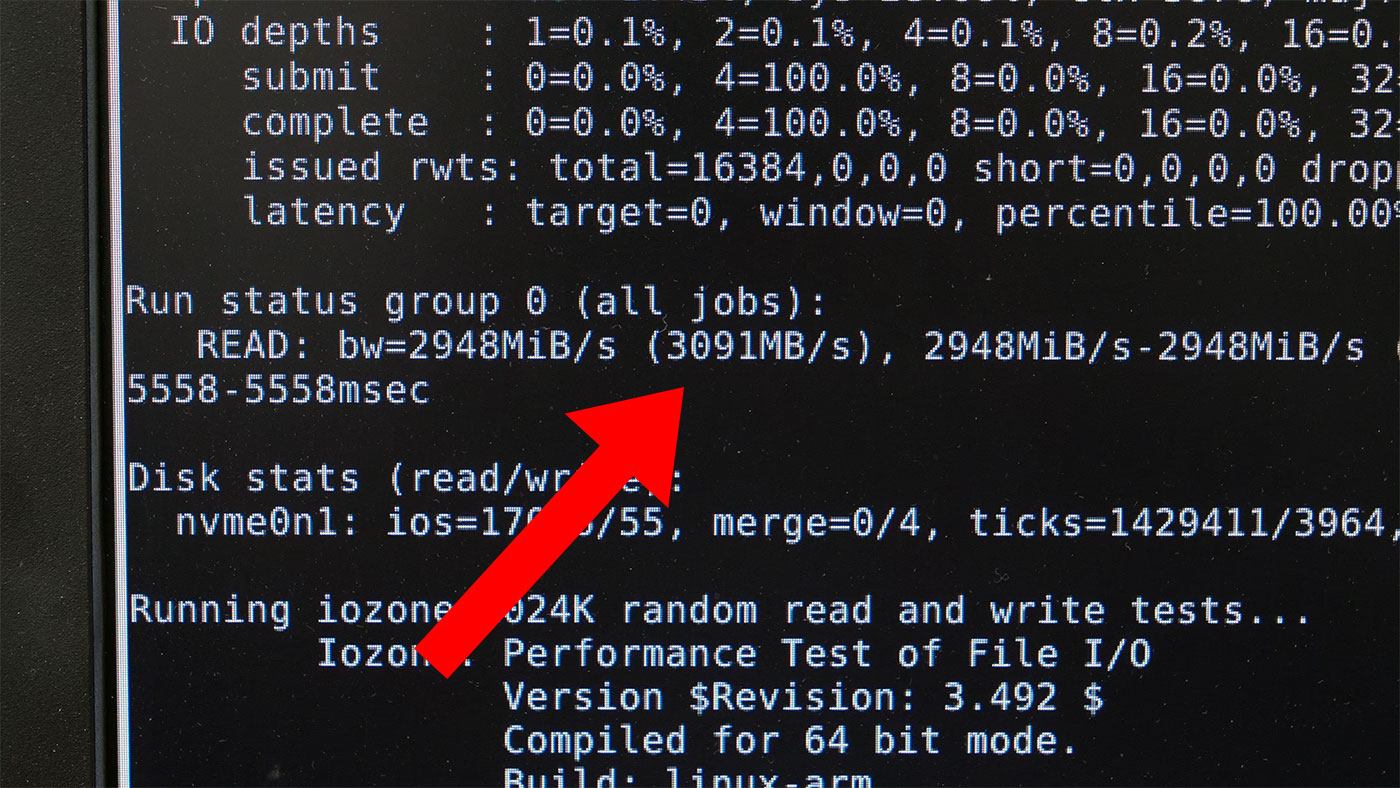
Even random access was three times faster than the Pi, clocking in at 1.3 GB/sec.
Booting from an SSD requires flashing a chip on the board over SPI, and that's not something for the feint of heart, but it's not that much different than upgrading the Compute Module's EEPROM. I just haven't tried it out yet.
Advanced Features
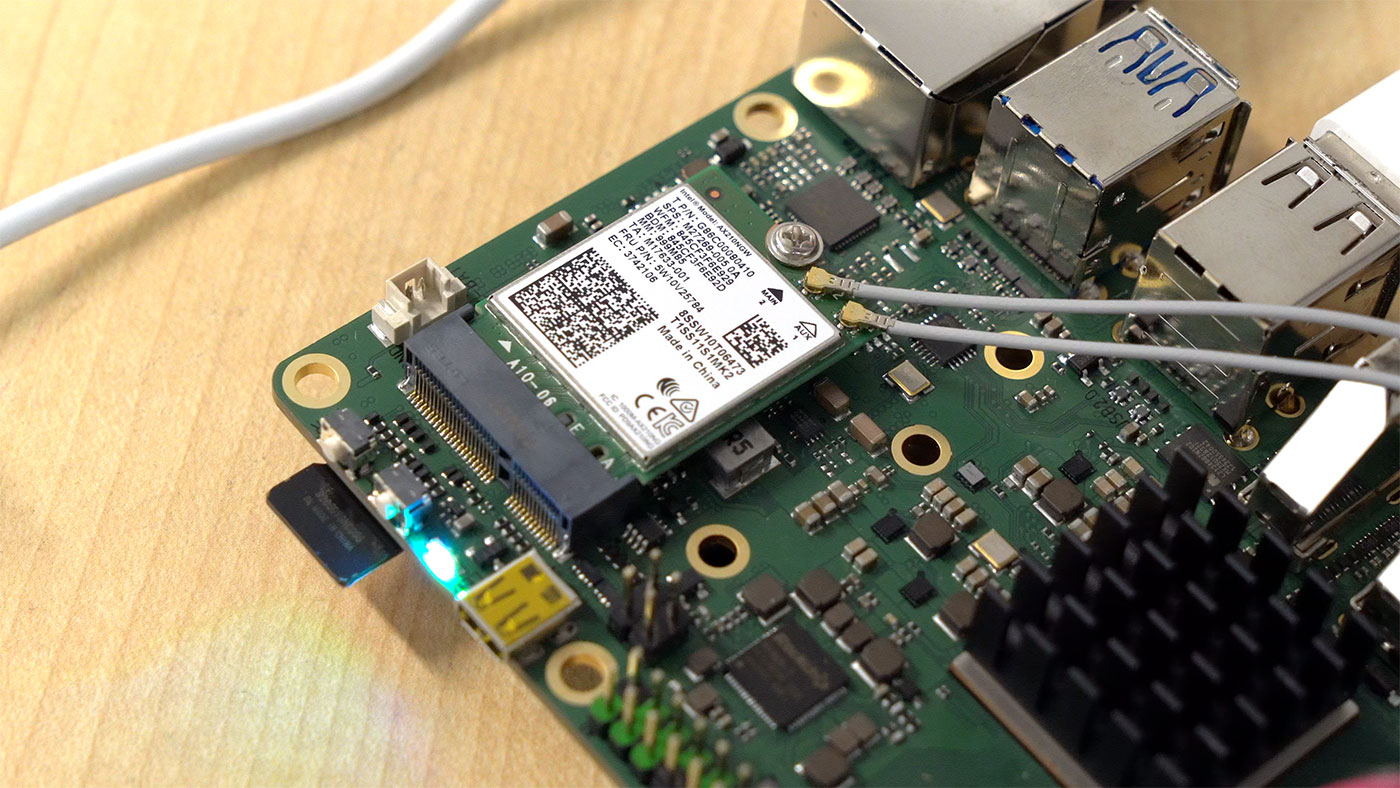
I also wanted to test the top A+E key M.2 slot. It's perfect for WiFi and I had an Intel AX210 I recently tested to 1.5 Gbps on the Raspberry Pi.
I tried getting it working on the Rock 5, but ran into issues. Bluetooth didn't work at all (which is a known issue), but I also couldn't install Intel's firmware since there was already some Intel firmware built with Rockchip sources.
The card would show up using nmcli, but I wasn't able to scan for networks or get connected, and the 6 GHz band is definitely not supported yet, even though I could get that working on the Pi.
Other people in the forums mentioned getting the AX210 working, though, so it was probably a bug I ran into. Radxa sells their own M.2 WiFi adapter, and for best out-of-the-box support, that's probably the way to go.
I wanted to test more PCIe devices in the bottom slot, though. In theory, any PCIe device can be plugged in using an M.2 to PCIe x16 adapter.
I've been plugging any and every PCIe device I could get my hands on into the Raspberry Pi and compiling the results of my testing into my Pi PCIe device database—many drivers tend to have issues with either ARM64 in general, or quirks in the PCIe implementation on the CM4 in particular.
But what about the newer RK3588 SoC? With PCIe Gen 3, a modest graphics card could give a huge boost for video transcoding, streaming, or even light gaming on Linux!
GPU on Rock 5?
I was even more intrigued when I saw this tweet.
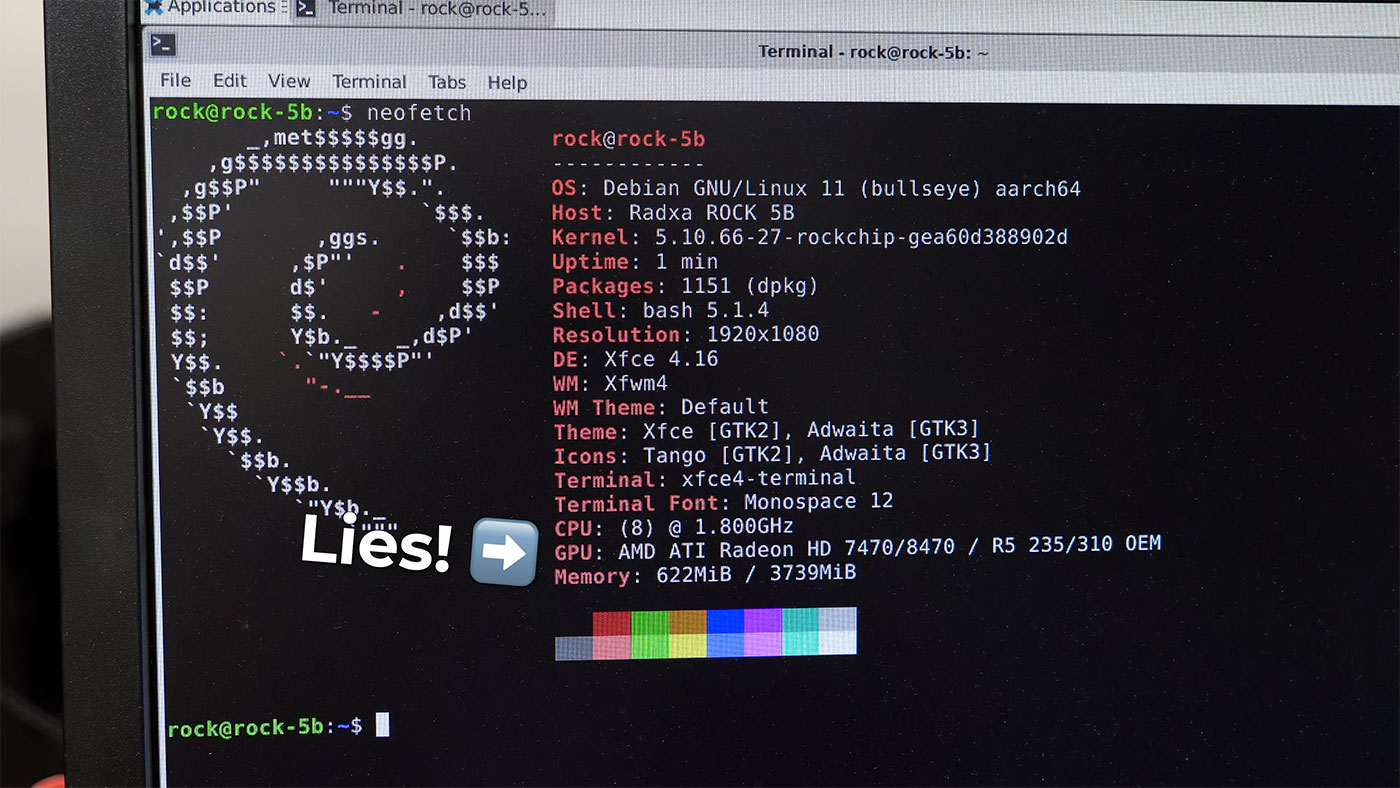
So I plugged in my Radeon HD 7470, installed AMD's firmware, ran neofetch, and, well... it's actually lying in the image above. The GPU driver isn't actually loaded, but since it's connected, neofetch thinks it's the active GPU.
But it's not. So of course I recompiled the kernel. But the Rock 5 wouldn't boot with my custom kernel—the blue LED started blinking and it wouldn't give me any output at all. So for now at least, I put a pin in that.
10 Gbps M.2 NIC
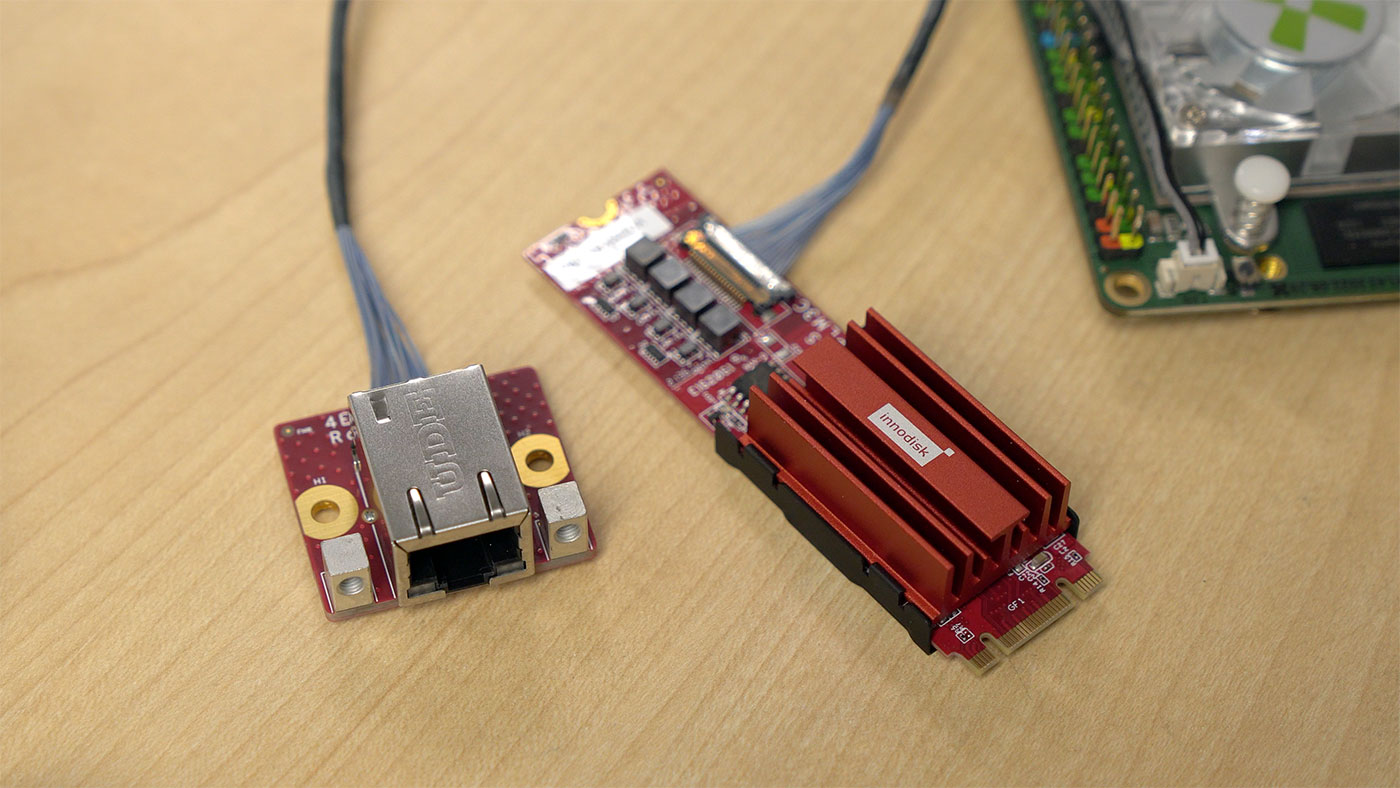
I also wanted to see if Innodisk's 10 Gbps NIC would work—it's the strangest network card I've ever used.
It showed up with lspci, so it was just a matter of getting a driver working.
Since there isn't a driver I can download for ARM Linux, I had to compile the driver in the Linux kernel—which I still couldn't get working yet.
So I put that on pause, too. But I will get back to it soon, because four PCI Express Gen 3 lanes affords 8 GT/sec, or about 4 GB/second of bandwidth.
According to Thomas Kaiser's research, I should be able to bifurcate the PCI Express lanes, so I could connect both a 10 gigabit network card and something like a storage controller, to build a pretty powerful NAS.
Accessories
To round things out, I tested some of Radxa's Rock 5 accessories:
- The RTC battery plugs into a header on the board and dangles off the edge.
- The Fan/heatsink combo worked okay, but only after I installed a different fan control package than the one included with the board. The included thermal paste—if you could call it that—came out more like a gooey snot than a paste, so I used a little Noctua NT-H2 instead. The fan is not too loud, though at lower speeds the one I had wobbled a bit and that made a more annoying sound.
- The standalone heatsink is adequate for most any workload, and as long as you're not fully enclosing the board, it should be enough to keep it cool.
- The 32 gigabyte eMMC module runs a bit faster than the microSD card interface, and unlike the Raspberry Pi CM4, you can use both eMMC and microSD storage at the same time.
Comparisons
It's time to compare the Rock 5 model B to some of its closest rivals, starting with the Raspberry Pi.
Raspberry Pi 4
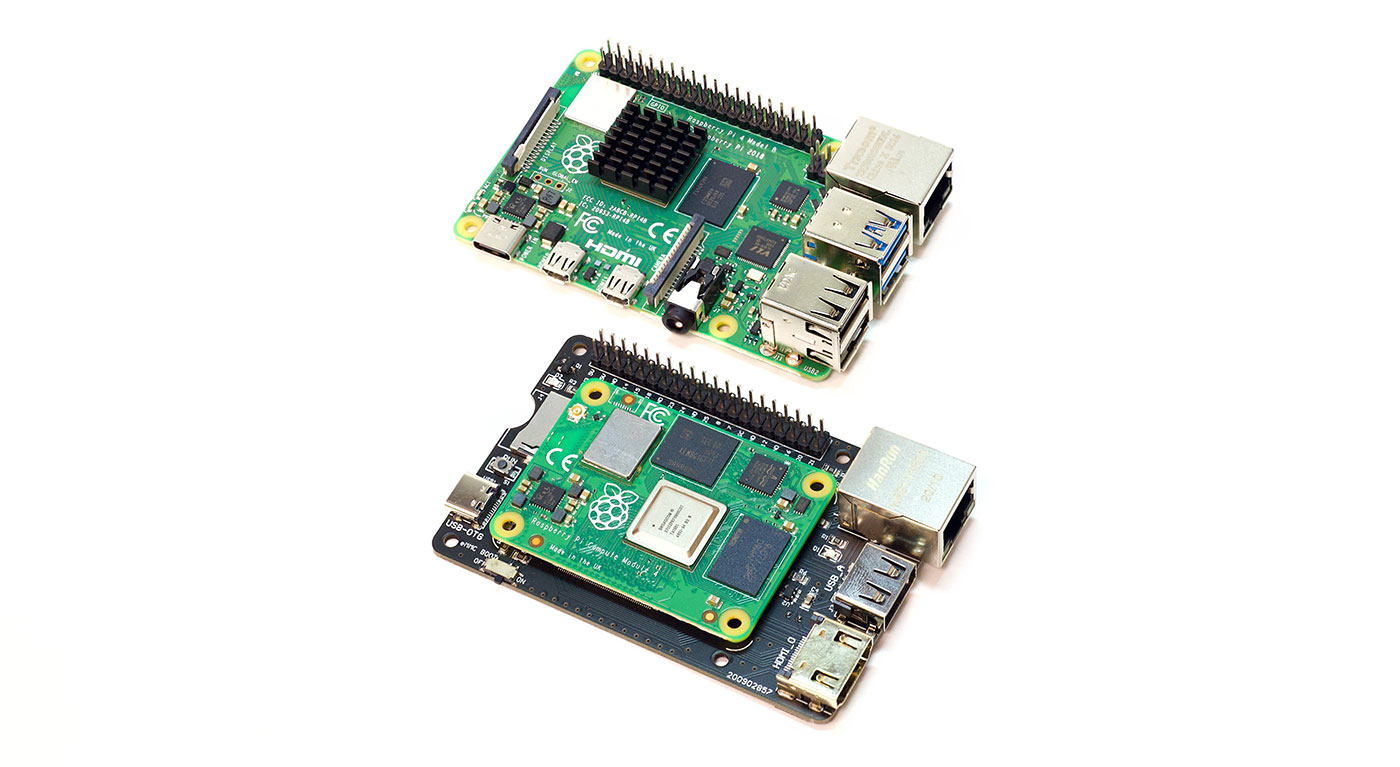
The Rock 5 trounces the Pi in both CPU performance and efficiency.
It's three times faster in Geekbench, it has faster built-in Ethernet, blazing fast M.2 NVMe support, another slot for fast WiFi. It's a different league entirely when it comes to the hardware.
But the software side still requires a bit more knowledge to be productive—and there's still the matter of sketchy Linux support. There are efforts to 'mainline' support for the Rockchip SoC, meaning you could just run plain Linux distros... but those efforts seem to be taking a while.
So right now, I wouldn't recommend this board to just anyone, at least when it comes to software and support, due to its high price.
Then again, I wouldn't recommend anyone pay over a hundred bucks for a Pi 4, either, but here we are...
Orange Pi 5
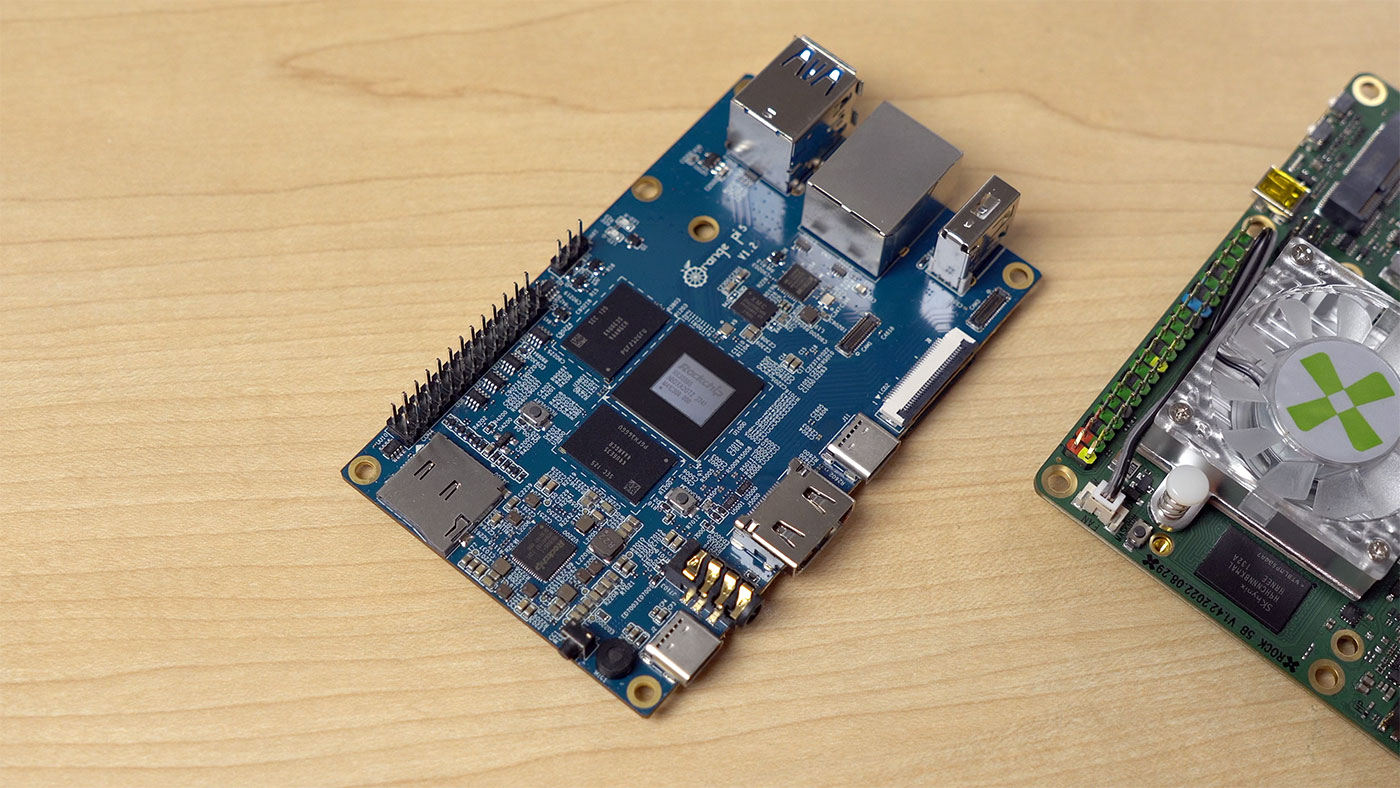
This Orange Pi 5 uses the same Rockchip RK3588—well, almost the same. The Orange Pi has the RK3588S, which has a little less bandwidth than the chip in the Rock 5.
It has a lone M.2 slot on the bottom running at PCIe Gen 2 speeds, which means this SSD only gets about 400 MB/sec—just as slow as on a Pi. The Orange Pi 5 also only has 1 Gbps Ethernet, and not even a full 40-pin GPIO header, but it does have a full size microSD card slot, so that's an upgrade!
But the Orange Pi 5 is a lot less expensive. You can get the same CPU and GPU performance, at least—and in my case it actually benchmarked a tiny bit faster—for half the price!
Khadas Edge 2
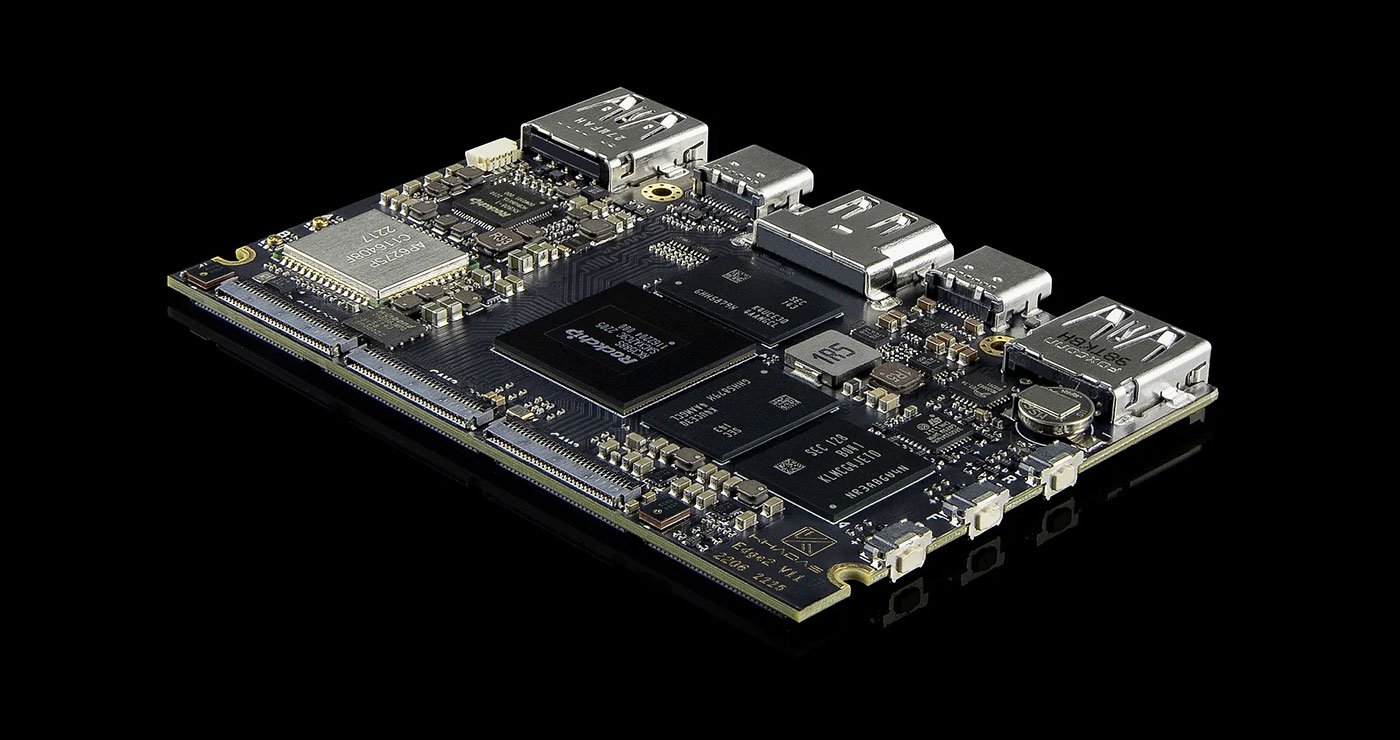
The Khadas Edge 2 also uses the slower RK3588 S, yet somehow costs more than the Rock 5 model B!
Besides the nicer marketing around Khadas' boards, I'm not quite sure why they cost so much. It doesn't have the same kind of community and support as the Pi, it doesn't have the higher specs of the Rock 5, and this board doesn't even include Ethernet... or an M.2 slot for that matter!
I just don't see the value, especially when Orange Pi has better features for a third of the price. You can buy a brand-new Ryzen Mini PC for the price of one of these Edge 2 boards!
Tiny PC

Speaking of Mini PCs, there are tons of these little 'thin client' PCs on eBay. I bought this Lenovo M710q with everything I needed—even a Windows license—for $120!
It includes a 4-core Intel i5 CPU, a hard drive, WiFi 6, an M.2 slot, and upgradeable memory.
It's a little faster in Geekbench, and a lot faster in Linpack, though efficiency is a little lower.
Running Ubuntu, it only uses 8W at idle, which is double the Rock 5, but still pretty efficient—especially considering this thing is spinning a hard drive inside!
But my point is, once you pass the $100 price point, you're competing with mini PCs like this. And once you go into the $200-300 price point, you could even get a brand new Ryzen PC!
Conclusion
But here I'm more interested in comparing ARM boards. And the Rock 5 is a huge upgrade over the Raspberry Pi 4, in terms of hardware and capability. Everything is faster, and by a lot. There's tons more IO, at the expense of a little extra board space.
But at what cost? Assuming Pis ever become available at MSRP again—and right now that still feels a long way off—the Pi still has two major advantages:
- A cheaper point of entry ($35)
- Better software and support
But focusing just on the hardware, the Rock 5, at $150 and up, is in a completely different price class. A tiny PC, complete with Power supply, a case, a hard drive, and even a Windows license, costs less than the base model Rock 5. And that's before you even add in necessities for the Rock 5 like a case and power adapter!
Radxa's done a decent job building up the Rock 5 ecosystem around the RK3588. Besides the Raspberry Pi, this is the best experience I've had with an ARM SBC. But it still has a long way to go before I would call it a 'Pi killer'. Docs need to be more beginner-friendly, the community needs to be less insulated in Discord, and the chip needs more mainline support.
I continue to follow Radxa closely, and I'll continue exploring GPU support with the RK3588—so if you're old school like me and still use RSS, make sure you're subscribe to this blog.
Comments
RK3588 is pretty good at decoding multiple 1080p streams see my demo https://jas-hacks.blogspot.com/2023/01/rk3588-decoding-rendering-16-108…
It's possible to install Arch ARM on the board. You can then chose from a bunch of different desktop environments/window managers.
Looks like a great buy in terms of performance but the software side makes the Raspberry PI better
Hi Jeff.
I use expressvpn and it works great. But when I was posting a comment on this post I got this error message:
Forbidden. Your IP belongs to a high spam risk network. Please, try again without VPN.
It looks like this is a cloudflare message because it come right after there security check.
Do you know if there is any way to fix it? I reported the issue to my expressvpn.
Hi Jeff! You forgot to include this link on your YouTube video 👍🏻
I wanted a tiny chromeOS Gadget and after a bunch of research Ive found radxa Rock 5B would be the top notch of sbc's... it can get an graphics card in the future and hopefully its chip gets mainline so for me its.. not yet there yet..
As for everything you have wrote...
I want to tell you that single board computers like Pi are mostly to be cheap yes but only a few alternatives offer more ram than the pi so this one in specific u can get 16gbs of ram and thats good.
The reason why people are ao actively looking into these imo is for the same reason as me: One small pocket little powerfull PC to transport and carry all major things I need.
In short: Chromecast with Google TV but ... with ChromeOS that would be me super happy. But since we cant have a portable cheap capable device like the chromecast for desktop mode then we got single board computers... does this makes sense ?
Yes cause I came from the Cloud Gaming.. so for me having a proper all in one system that can run Geforce Now cloud games on the go on tv on monitor and capable of wifi 6 and mouse n keyboard.. easy peazy is / was my goal so Radxa Rock 5B does its job. However and to really make it happen its up yo OpenFyde (fork of FydeOS) to allow us to download gApps and update us constantly.
This is my take on sbc'ers hope this makes some sense...
because in terms of why not getting a tiny pc well that lenovo is not so tiny is it ? Its not a pi size computer or a chromecast size caster... u failed there.. for a better perspective Morefine pcs are tiny and those are alike pi computers... but even that would probably have me look into snapdragon single board computers but I couldnt find a decent small one like I wanted.
Im def not an linux hardcore user... Im more like a ChromeOS user but I dont want an laptop I want a sbc for the convenience. Anyway Great Review ma brather.
yep, and sadly, the Rock Pi 5 is chock full of bugs.
Try Fedora on it. I was told by distributors it worked out of the box, and they use far more up to date software then debian or ubuntu.. Arch would be another good choice. There has been quite a bit of work done even in the kernel for ARM with the 6.0 kernel and drivers. Especially since Linus, started using the Apple M1. In otherwords many of the bugs you are experiencing may already be fixed and it is just the software hasn't been updated. Fedora strives to be as close to their x86 release as possible.
Have you tried the linux-next kernel? I see that the Rock 5 has a dts file there for 5 and the upcoming 5 a
This looks promising for the rk3588 family.
From Collabora
kernel-62-more-rust-support-for-drivers.html
and
pancsf-a-new-drm-driver-for-mali-csf-based-gpus.html
I tried a few images with the 6.x kernel from Armbian. From their download site with the ci pipeline builds and also the rpardini auto build images.
Latest image has kernel 6.2.2. Armbian_20230305a-rpardini_Rock-5b_kinetic_edge_6.2.2.img
The Rock 5b boots, but the LED stays blue and never turns green. But again, it still fully boots. But there is no hardware visible.
When I connect via serial console, you can login. Running lspci shows nothing.
The ax210 network adapter doesn't work right with kernels before 5.15, not surprised you ran into issues.
I think the huge lead that raspberry pi has is software support, community and the Cambridge.
P.S. You are a hero if mine with the work and passion you put into evaluating these new rpi competitors.
I don't know about Pi4 prices where you are Jeff, but here in the UK at the moment:
- Pi4 goes for around £150 (4GB RAM) and £180 (8GB RAM) https://www.amazon.co.uk/Raspberry-Pi-Model-4GB/dp/B09TTKT94J
- Rock 5 B goes for £161 (8GB RAM) https://uk.rs-online.com/web/p/rock-sbc-boards/2493159
At those prices the Rock 5 is a no brainer, specially since the software has gotten so much better recently
If it's compute you're after buy a s/h PC. It already has a power supply and a case.
The only reason to buy a bare board device is for the I/O. Any talk of that and crucially the libraries and packages to use that should be right at the heart of any Pi-style review
Rock 5 B is fanless and quiet while TinyMiniMicro PC, like the Lenovo M710q has active cooling which could be vvery noisy. So I cannot see competition there...
Hi, I haven't got to play with any of the toys like this (I got a 4GB pi 4 model B before the shortage started, and with no end in sight probably no more raspberry pi's for me), but I have been poking around turning my Ryzen 5950 workstation into even more of a workstation than before.
I came across these Ceacent PLX PCIe switch cards, they're within affordable range now ($100 or so), so you can run multiple pcie devices off a single pcie slot, there is no need at all for bifurcation ability.
You may be able to get great results with one of these things to run massive amounts of storage and high speed networking.
I am somewhat tempted to experiment with NAS use cases because low power consumption is attractive.
It's rather disingenuous comparing a Raspberry Pi 4 to the Rock 5 given the fact that the Rock is on a form factor that is 52% larger than the Pi.
There is no telling what RPi could come up with if they pursued the 100 x 72 mm form factor.
Hey Jeff,
how about recap hows the situation now in end of year 2023 with rockpi5?
While the Raspberry Pis were out of stock, I bought 3 Radxa SBCs. The hardware is good but the documentation and support is not.
Well i wanted a SBC to be a PUBG and COD board and maybe little bit of Media Center - so I thought that Radxa's Rock 5 model B would be perfect for it... However do you know any other AMD system that could run Android for gaming. All help would be great.